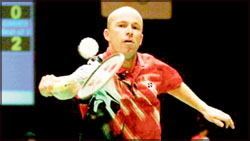|

Badminton
The fastest racket sport?
At the sight of the topic, you may wonder, "hey, we know badminton!
What is new about it?" Well, yes, you may know quite a lot; for example,
that it is a racket game, it uses a shuttlecock which should always go
above the net and the basic rules.
But, in today's article, we are going to give you an insight to the
less popular information regarding badminton. Therefore, let's see how
this game has evolved since its birth, and what significances there are
in this game. Starting off with some basics, it is a game where two
teams, either playing as single players or two players per team,
participate.
This also is an Olympic sport where the game is played in five ways,
namely men's and women's singles, men's
 and
women's doubles and mixed doubles, where a team comprises a man and a
woman. The Badminton World Federation (BWF) governs the sport, and its
headquarters is located in Kuala Lumpur, Malaysia. and
women's doubles and mixed doubles, where a team comprises a man and a
woman. The Badminton World Federation (BWF) governs the sport, and its
headquarters is located in Kuala Lumpur, Malaysia.
****
Birth of the game
Where the game badminton is concerned, the shuttlecock and the racket
play a key role. The origin of the shuttlecock can be traced back to
over two thousand years, to Greece.
This was introduced across India, China and Thailand thereafter.
However, during the Medieval period (5th to 16th century), there has
been a popular sport called Battledore and Shuttlecock in England. This
can be considered as the start of badminton.
What was done in this game was keeping the shuttlecock in the air for
the maximum amount of time, without letting it fall to the ground, by
striking it upwards using paddles which were called battledores.
Children got together in groups and enjoyed this game in those times.
This was so popular during the Medieval period, that it had turned out
to become a problem to people passing by in London because children were
playing this game everywhere.
 The
initiation of modern badminton can be traced to the 1860s, and that
honour would go to the British Army officers who were working in the
Pune region of India. They have started to play the game, battledore and
shuttlecock to pass time, and had gone to the extent of using a net to
add more competition to the game. The
initiation of modern badminton can be traced to the 1860s, and that
honour would go to the British Army officers who were working in the
Pune region of India. They have started to play the game, battledore and
shuttlecock to pass time, and had gone to the extent of using a net to
add more competition to the game.
This game was called Poona since it originated in Pune. Now, you may
be wondering how this got the name 'Badminton'. Here's how... At the
period when Poona was popular, the Duke of Beaufort had let soldiers
play the game in his estate which was called 'Badminton House'.
Since the game was played here, people started referring to the game
as 'Badminton', and since then, it has been called so, and has become
more organised and competitive over many years of evolution.
*****
Some important facts
* The full length of the court is 13.4 metres. The full width of the
court is 6.1 metres, and in singles, this width is reduced to 5.18 metres. The short service line is at a distance of
1.98 metres from the net.
is reduced to 5.18 metres. The short service line is at a distance of
1.98 metres from the net.
* The net is 1.55 metres (5 feet and 1 inch) high at the edges and
1.524 metres (5 feet) high in the centre.
* Each game is played up to 21 points. If the score reaches 20-20,
then the game continues until one side gains a two point lead (such as
24-22), up to a maximum of 30 points, which means that even 30-29 can
become a winning score.
* High quality rackets which are used by professionals may weigh
between 70 to 100 grams without strings. This is achieved by using
carbon fibre to construct the racket, which is a strong, lightweight
material.
* Badminton strings are thin, with high performing strings in the
range of about 0.65 to 0.73 millimetres thickness. String tension is
normally in the range of 80 to 130 Newtons.
* Men's doubles player Fu Haifeng of China set the official world
smash record of 332 km/h on June 3, 2005 in the Sudirman Cup. The
fastest smash recorded in the singles competition was 298 km/h by
Kenneth Jonassen of Denmark.
* The Guinness World Record for the longest game was made in Ireland
in 2005, in a game which was a Badminton Marathon held in aid of Temple
Street Children's University Hospital. It went on for 24 hours, 21
minutes and 19 seconds. Amazing, isn't it?
Aravinda Dassanayake |
